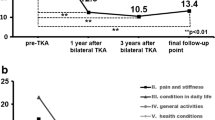Abstract
Background
Recently, the Japanese knee osteoarthritis measure (JKOM), a new disease-specific and patient-derived quality of life (QOL) measure, has been developed. The objectives of this study were to longitudinally evaluate QOL assessed by JKOM and objective outcomes including knee society score (KSS), range of motion (ROM), and timed up and go test (TUG) of patients who underwent bilateral total knee arthroplasties (TKAs) for osteoarthritis; to evaluate correlations between JKOM and those objective outcomes; and to test our hypothesis that increased maximum flexion leads to better JKOM.
Methods
Forty patients with bilateral TKAs and ≥ 3-year follow-up were included. There were 35 female and 5 male patients with a mean patient age of 74 years. They were evaluated preoperatively (Pre), 5–29 months after unilateral TKA (after U), 12–21 months after bilateral TKAs (1 year after B), 24–34 months after bilateral TKAs (2 years after B), and 36–46 months after bilateral TKAs (3 years after B) using JKOM, KSS, TUG, and ROM.
Results
Improvements in JKOM and TUG were statistically significant between “Pre” and “after U”, and between the “after U” and “1 year after B”. Improvements in the KSS function score were statistically significant between “after U” and “1 year after B” but not between “Pre” and “after U”. The improvements in the JKOM scores, the KSS function score, and TUG did not increase after the 1-year follow-up but was maintained at “3 years after B”. The maximum flexion value did not change among the evaluation time points. There were statistically significant correlations between JKOM with KSS and TUG but not with ROM.
Conclusions
There were statistically significant correlations between JKOM with KSS and TUG but not with ROM. Therefore, our hypothesis was false even in a Japanese population.





Similar content being viewed by others
References
Bellamy N, Buchanan WW, Goldsmith CH, Campbell J, Stitt LW. Validation study of WOMAC: a health status instrument for measuring clinically important patient relevant outcomes to antirheumatic drug therapy in patients with osteoarthritis of the hip or knee. J Rheumatol. 1988;15(12):1833–40.
Ware JE, Sherbourne CD. The MOS 36-item short-form health survey (SF-36). Med Care. 1992;30(6):473–83.
Anderson JG, Wixson RL, Tsai D, Stulberg SD, Chang RW. Functional outcome and patient satisfaction in total knee patients over the age of 75. J Arthroplasty. 1996;11(7):831–40.
Lingard EA, Katz JN, Wright RJ, Wright EA, Sledge CB. Validity and responsiveness of the knee society clinical rating system in comparison with the SF-36 and WOMAC. J Bone Joint Surg Am. 2001;83(12):1856–64.
Bullens PH, van Loon CJM, Malefijt MCW, Laan RFJM, Veth RPH. Patient satisfaction after total knee arthroplasty: a comparison between subjective and objective outcome assessments. J Arthroplasty. 2001;16(6):740–7.
Miner AL, Lingard EA, Wright EA, Sledge CB, Katz JN. Knee range of motion after total knee arthroplasty: how important is this as an outcome measure? J Arthroplasty. 2003;18(3):286–94.
Park KK, Chang CB, Kang YG, Seong SC, Kim TK. Correlation of maximum flexion with clinical outcome after total knee replacement in Asian patients. J Bone Joint Surg Br. 2007;89(5):604–8.
Padua R, Ceccarelli E, Bondi R, Campi A, Padua L. Range of motion correlates with patient perception of TKA outcome. Clin Orthop Relat Res. 2007;460:174–7.
Kwon SK, Kang YG, Kim SJ, Chang CB, Seong SC, Kim TK. Correlation between commonly used clinical outcome scales and patient satisfaction after total knee arthroplasty. J Arthroplasty. 2010;25(7):1125–30.
Devers BN, Conditt MA, Jamieson ML, Driscoll MD, Noble PC, Parsley BS. Does greater knee flexion increase patient function and satisfaction after total knee arthroplasty? J Arthroplasty. 2011;26(2):178–86.
Insall JN, Dorr LD, Scott RD, Scott WN. Rationale of the knee society clinical rating system. Clin Orthop Relat Res. 1989;248:13–4.
Podsiadol D, Richardson S. The timed “up & go”: a test of basic functional mobility for frail elderly persons. J Am Geriatr Soc. 1991;39(2):142–8.
Akai M, Doi T, Fujino K, Iwaya T, Kurosawa H, Nasu T. An outcome measure for Japanese people with knee osteoarthritis. J Rheumatol. 2005;32(8):1524–32.
Mizner RL, Petterson SC, Clements KE, Zeni JA Jr, Irrgang JJ, Snyder-Mackler L. Measuring functional improvement after total knee arthroplasty requires both performance-based and patient-report assessments: a longitudinal analysis of outcomes. J Arthroplasty. 2011;26(5):728–37.
Lozano-Calderon SA, Shen J, Doumato DF, Greene DA, Zelicof SB. Cruciate-retaining vs posterior-substituting inserts in total knee arthroplasty: functional outcome comparison. J Arthroplasty. 2013;28(2):234–42.
Conflict of interest
The authors declare that they have no conflict of interest.
Author information
Authors and Affiliations
Corresponding author
About this article
Cite this article
Sugita, T., Kikuchi, Y., Aizawa, T. et al. Quality of life after bilateral total knee arthroplasty determined by a 3-year longitudinal evaluation using the Japanese knee osteoarthritis measure. J Orthop Sci 20, 137–142 (2015). https://doi.org/10.1007/s00776-014-0645-9
Received:
Accepted:
Published:
Issue Date:
DOI: https://doi.org/10.1007/s00776-014-0645-9




